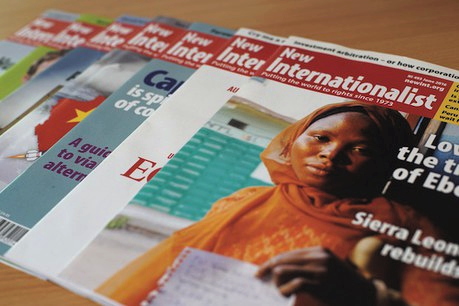The Immigrant Workers Freedom Ride revives the U.S. immigration debate.
Published in the November 2003 issue of the New Internationalist.
“In a few intense months we have challenged and changed America’s attitudes about immigrants,” said May Chen, the daughter of Chinese immigrants and textile workers union vice president, speaking before a massive October 4th rally in New York City’s Flushing Meadows Park.
The festival served as the closing ceremony for the Immigrant Workers Freedom Ride. Over 900 activists of 50 different nationalities in this campaign departed in mid-September from 10 cities to demand amnesty for undocumented workers in the United States. By the time they arrived in New York, their bus tour had made over 100 stops at union halls and churches, plus a lobbying trip to Washington, D.C, reviving a national debate about immigration policy that had been moribund since 9/11.
“I’m doing this for dad, and for my sister, who were discriminated against because they were immigrants,” says Diana Chavez, 28, who rode from Los Angeles. “Because my dad has darker skin, employers thought, ‘he’s just a stupid Mexican.’ I want to show him that we can change this nation.”
Ramon Ramirez, president of a farm workers union in Oregon, joined the Ride with his wife and three kids. “We are struggling for a new legalization,” he said, pointing to demands for citizenship opportunities, family reunification, and labor protections. “Our day is going to come.”
The estimated 100,000 who gathered in New York City embodied an internationalist America. Union banners flew alongside the colors of Mexico, Puerto Rico, Haiti, Ecuador, and dozens of other countries. “Let me see you swing those flags,” yelled hip-hop performer Wyclef Jean, who elevated the crowd as he rapped in three languages. Waving signs read: “We are all immigrants” and “Amnistia Ahora!”
Armando Blas Garcia, who joined the Freedom Ride from Minneapolis with his 16-year-old-daughter, told Workday Minnesota: “To people who say this has nothing to do with them, I say, “Who does your yard work? Who makes your fast food?… Who cleans your hotel rooms? The food on your table every night, how do you think it got there?”
“America came to them first, creating sweatshop economies,” Ben McKean of United Students Against Sweatshops said at the rally.
Today’s immigrant rights activists take their inspiration from the militant Freedom Rides of 1961, with which the U.S. Civil Rights movement challenged the apartheid of the Deep South. While the 2003 rides did not draw the same type of savage response from white racists, some activists nevertheless faced real risks. Two buses from Los Angeles were stopped by immigration authorities near El Paso, Texas.
“‘Show me proof of your citizenship,’ they told us,” recounted Maria Elena Durazo, the Freedom Ride chairwoman. “They asked every single one of us, one by one, but none of us spoke.”
“When they put us in a cell, people were scared and crying,” says Chavez, who was aboard one of the busses that was held. “We held each other and said we wouldn’t let them intimidate us. We sang the whole time.”
“In that moment of danger,” Durazo says, “we became children… of the African American fighters for Civil Rights.”
Spanish-language TV and radio stations in the Southwest treated the Ride’s stop by La Migra as emergency breaking news. Politicians quickly responded by pressuring the Department of Homeland Security, which released the activists after four hours.
This responsiveness illustrates the success with which activists have forced immigration reform back onto the national stage. Polls show that amnesty is the top political issue for Hispanics, who this year surpassed African Americans to become the largest minority group in the United States. Traditionally, power in the hemisphere has flowed North to South, with the United States intervening in Latin American affairs. But, with actions like the Immigrant Workers Freedom Ride, Latinos are increasingly reshaping U.S. politics as well.
Several factors have contributed to this reversal of political fortune. In the mid-1990s, several million illegal immigrants became eligible for citizenship based on a 1986 amnesty, and applications for naturalization soared. Moreover, many children of Latino immigrants who were born in the U.S. are now coming of voting age. Finally, the Labor movement is reaching out to Latinos and other immigrants as never before, recognizing that these constituencies are providing critical leadership in campaigns to organize the low-wage workforce.
As a result of aggressive voter registration drives, Latinos in 2004 will constitute an estimated 9% of the electorate (up from 7% in 2000).
Already, it’s rare to find a national politician in the U.S. who won’t attempt to stammer a few words of “Spanglish” whenever they might court new “amigos.” (In one gaffe, President Bush even used the term to greet French-speaking dignitaries.) The workers on the Freedom Ride, however, are looking for more than false camaraderie and fickle promises from politicians.
“People should be in charge, not them,” says Chavez. “We’re tired of racism and discrimination. Immigrants aren’t going to stay in the shadows anymore.”
__________
Research assistance for this article provided by Jason Rowe.
